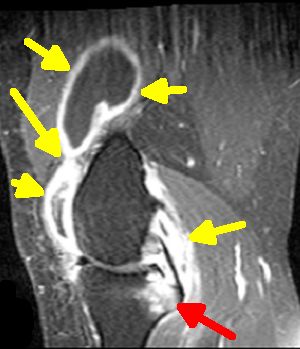A big knee in Psoriatic Arthritis
Introduction
There are several distinct patterns of arthritis that patients with psoriasis get. One of these is an isolated arthritis with a large degree of swelling of the knee joint without disease elsewhere. This page explains what is known about this type of PsA and its link to the enthesis.
Clinical Features
The arthritis may come on fairly quickly or follow a minor injury. Because only one joint is involved patients often get referred to an orthopaedic surgeon and are investigated for a structural problem such as a ruptured ligament or torn meniscus. Apart from florid joint swelling and fluid accumulation a patient may have an otherwise normal MRI scan and a normal arthroscopy. This then prompts a Rheumatology evaluation.
Sometimes the degree of knee joint swelling can be very large with a massive amount of fluid accumulation in the joint. Despite this the joint is comparatively painless. Movement is restricted by the degree of swelling.
In relative terms the progression of knee joint destruction is relatively slow compared to the degree of joint swelling. The same degree of swelling in septic arthritis (infection related) could destroy a joint in a week!
Little research into this type of arthritis has been performed.
Enthesitis and the Big knee
Although other types of PsA are associated with enthesopathy it is less evident in this type of disease is specifically linked to enthesitis. It is not really linked to nail disease which is known to be strongly linked to enthesitis.
Patients with the pattern of disease tend to have very few joints involved.
There is no experimental model of this type of PsA so it is poorly understood.
Presentation to the Rheumatology clinic
Not infrequently patients may come via an orthopaedic colleague who notes a large degree of inflammation but no structural damage.
Not infrequently the patient may not be aware that they have psoriasis and may have one small fleck
Some cases will have no psoriasis but a parent, sibling or child will have psoriasis. On this basis a rheumatologist may then diagnose PsA.
Many of these cases with the big knee may have no relatives with psoriasis and may develop psoriasis several years after the knee joint swelling.
In people with chronic knee joint swelling without any personal or family history of psoriasis, rheumatologists will often view the condition as likely being linked to the psoriasis spectrum.

|
| This is an MRI scan of a patient with a large degree of knee swelling. The yellow arrows point to extensive joint lining inflammation termed synovitis. The black region inside the white rings represents a large degree of joint fluid accumulation. The red arrow shows a region of extensive bone oedema or bone marrow inflammation at the enthesis of the posterior cruciate ligament suggesting that this case may be linked to enthesitis. |
For isolated persistent knee swelling without obvious psoriasis a synovial biopsy and other blood tests to exclude other diagnoses may be carried out.
Management
Joint drainage and fluid analysis to exclude infection or crystal mediated diseases such as gout are needed.
Injection of corticosteroids into joint accompanied by 24-48 hours rest may help.
A good response to an injection without complete resolution may be helped by a further injection.
Agents such as sulphasalazine or methotrexate can help but are not proven.
The lining of the joint can be stripped out in a procedure called a synovectomy in resistant cases. Unfortunately, the problem tends to recur.
A chemical synovectomy has also been used to treat this condition.
A radioisotope synovectomy with Yttrium has also been reported.
For resistant disease the biological agents may have a role. This has been reported for the anti-TNF class of drugs. However, most biological agents studies have been done on people with an average of 10 swollen joints and not one or two. It is hard to extrapolate from these studies what will happen in cases with one large joint involved. However, there are reports of anti-TNF agents use in this setting [1].
Practical considerations
An arthritis in a single knee joint in a patient with psoriasis that does not show any response to therapy should be considered for a biopsy. In our experience as such cases often get referred to orthopaedics in the first instance this procedure may already be done.
Even if a doctor is happy with the diagnosis, fluid drained from the knee should be re-evaluated periodically for infections or crystal related arthritis.
Unlike most other types of PsA which are strongly linked to enthesitis this pattern of PsA with massive thickening of the synovium is less clearly connected to diseases of the enthesis.
References
